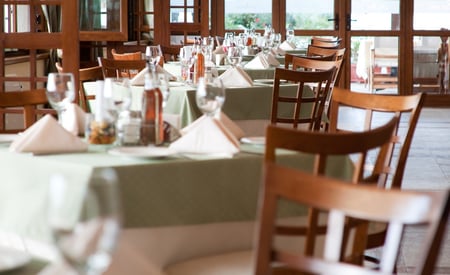As if losing David Bowie and Prince weren’t bad enough, 2016 was also a gloomy year for the restaurant industry. In terms of sales, it was the worst year since the end of the recession, reports The Restaurant Industry Snapshot from TDn2K, which tracks weekly sales from nearly 26,000 restaurant units and more than 130 brands.

“Traffic growth year-to-date has been -3.0 percent, a very troubling scenario compared with the -0.8 percent reported for all of 2015,” Victor Fernandez, Executive Director of Insights and Knowledge for TDn2K, said in an October 2016 release.
If the slowdown continues, what can operators do about it? Here’s a rundown on the causes of the restaurant recession, plus some ideas for boosting business.
Causes of the restaurant recession
Industry watchers point to three main restaurant industry trends. One is rising menu prices. As restaurant meals get more expensive, grocery prices have declined. Forbes contributor Danielle Marceau lays it out: “In fact, restaurant prices are up 2.4%, while food at home prices are down 2.2% versus last year. During the same period, Real Average Hourly Earnings increased only 1.4%, meaning that consumers are losing spending power when looking at eating at restaurants, but increasing spending power when eating at home since prices are declining for food at home.”
Why are restaurant costs rising? In large part, it’s due to increased labor costs. The minimum wage has risen, by law, in many states and cities even as the federal minimum wage remains at $7.25. Wages for higher-paid employees have also risen to keep pace.
The third problem: market saturation. From 2006 to 2014, the number of restaurants in the U.S. grew 7.3 percent as the population increased by 6.9 percent. As foodies celebrate the resurgence of the independent fine-dining scene in U.S. cities, restaurant owners see cutthroat competition, from Louisville to Atlanta to Portland.
How to beat the restaurant recession
The outlook for 2017 isn’t all bad. In 2016, quick service, upscale casual and fine dining segments saw positive growth, TDn2K reports. This suggests consumers still value quick, affordable convenience and high-end dining experiences. Restaurants in the middle, particularly casual dining, are the ones bearing the brunt of the slowdown. Also, food costs have remained low, helping operators make up for increased labor costs.
Here are some ideas for growing even in the face of reduced spending and increased competition.
Focus on reducing turnover. While there’s not much you can do about rising wages, keeping your employees around longer can trim labor costs and improve service. “Turnover has been trending up since 2010 and, particularly for restaurant managers, has reached levels surpassing anything reported for over ten years,” TDn2K reports. “In the current environment of falling restaurant sales, this is especially troubling since TDn2K research has continuously shown a relationship between management turnover and a brand’s sales and traffic results.”
One way to retain your best employees is to empower them. At Pasadena diner (and HBC customer) Pie ‘N Burger, where the average tenure of staff is 15 years, owner Michael Osborn trusts employees to make their own decisions about things like scheduling and handling customer crises: "I have a rule that there's no wrong decision if you went about it in the right way." Another way is to use tenure-extending employment milestones, training expert Jim Sullivan says: If a grill cook stays 27 months, on average, he would “institute mandatory pay and performance reviews for my grill cooks at six-month intervals, give them free branded apparel at 20 months, an automatic pay raise at 23 months, and a small bonus check at 26 months.”
Identify your unique selling proposition — and capitalize on it. Why would a customer choose your burger restaurant over the 11 others in the area? What do you do better than everyone else? The answer could be your perfect brioche buns, your house-made condiments, your well-known chef or your happy-hour specials. But if you don’t know what that USP is, you’ll have a hard time standing out in the marketplace.
Invest in durable equipment. When facing uncertain times, operators are tempted to save money where they can — including on equipment. That’s a mistake. If your walk-in compressor dies, or your poor-quality blender starts to smoke, your operations will be crippled.
Keep an eye on competitors. Investment firm Morningstar picked out three fast-casual brands it thinks will grow despite a restaurant recession: Sweetgreen, Mendocino Farms and Blaze Pizza. It’s worth looking at companies like these to see what they’re doing right in areas such as convenience, menu pricing and overall ambiance. Operators may pick up a few ideas for improvement that will keep them going strong in 2017 and beyond.
Do you have some advice for growing in the face of a restaurant industry slowdown? Tell us about it and we may feature your business in a future post.


